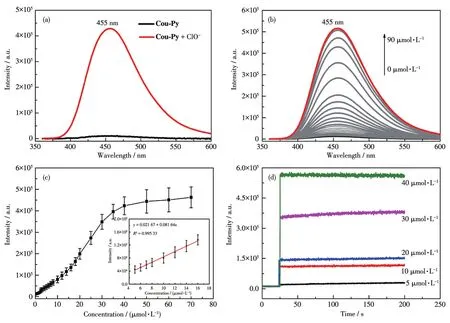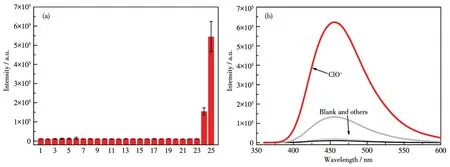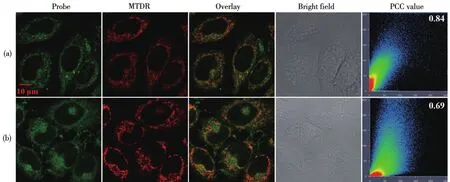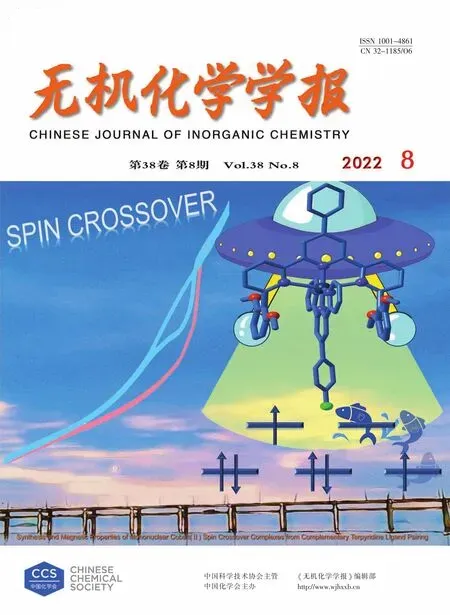A Fast-Responsive Mitochondria-Targeting Fluorescent Probe Detecting Hypochlorite in Living Cells and Zebrafish
ZHANG Chang-LiZHANG Jing-JingSHEN YouLU Jia-ChengHUANG FangXU Li*,
(1Key Laboratory of Advanced Functional Materials of Nanjing,School of Environmental Science,Nanjing Xiaozhuang University,Nanjing 211171,China)(2College of Science,Nanjing Forestry University,Nanjing 210093,China)
Abstract:Herein,a mitochondria-targeting fluorescent probe Cou-Py has been designed and synthesized for sensing hypochlorite(ClO-).Cou-Py exhibited very weak fluorescence due to the C=N isomerization of the oxime group in the excited state and recovers fluorescence within 5 s based on a ClO--triggered deoximation reaction.Additionally,Cou-Py showed high selectivity toward ClO-over other reactive oxygen species(ROS)and owned a low detection limit(6.87 nmol·L-1)for ClO-.Importantly,Cou-Py has been successfully employed for visualizing ClO-in the mitochondria of MCF-7 cells as well as zebrafish larvae.
Keywords:fluorescent targeting probe;hypochlorite;zebrafish imaging;coumarin
Abstract:A new inorganic-organic hybrid(H2L)2(HL)2L(PMo12O40)2·2H2O(marked as PMo12)derived from the selfassembling of N-containing ligands L(L=1,3-bis(1-imidazolyl)propane)and inorganic polyoxometalates(H3PMo12O40)have been hydrothermally synthesized.The compound was characterized by infrared spectroscopy(IR),thermal gravity(TG),X-ray photoelectron spectroscopy(XPS),X-ray diffraction(XRD),and single-crystal X-ray diffraction.Studies on single-crystal X-ray diffraction reveal that the compound displays 3D structures.Then a bisphenol A(BPA)electrochemical sensor based on PMo12and multi-walled carbon nanotubes(MWCNTs)has been successfully constructed.The detection limit was 0.5 μmol·L-1(S/N=3)in a range of 1-20 μmol·L-1,and the sensor had good anti-interference and stability.CCDC:1054587,PMo12.
Keywords:crystal growth;polyoxometalates;electroanalytical;sensor
0 Introduction
Hypochlorite(ClO-),as one of the most important and highly reactive oxygen species(ROS),plays a crucial role in a variety of physiological processes[1-2].It not only contributes to the defense of bacterial and inflammatory but also acts as a natural adjuvant of adaptive immunity[3-5].However,the excessive level of this strong oxidant in living systems can lead to oxidative stress,cellular damage,and tissue destruction,which will cause a series of related diseases,such as inflammatory diseases,cardiovascular diseases,lung injury,cardiopathy,angiocardiopathy,arthropathy,renal function damage,and even cancers[5-7].The mito-chondria,as the main source of hypochlorite production,play an important role in life-sustaining activities,however,the build-up of hypochlorite in mitochondria can result in cell death and various diseases[8-10].Therefore,the development of mitochondria-targetable probes for ClO-detection in live cells and animals will help further our knowledge of the chemical and biological properties of ClO-in mitochondria.
As a classic noninvasive method,the fluorescence technique has been widely used as an effective tool for the detection of biomolecules in living cells and animals,because of its high selectivity,good sensitivity,ready operation,and rapid response rate[11-13].Recently,a variety of mitochondria-targetable fluorescent probes for specific detection of ClO-have been designed and realized to trace ClO-in vitroandin vivo[14-29].
It is known that the basal ClO-level in cells is quite low.It is reported that the average ClO-generation from neutrophils is 0.47 nmol·min-1per 106cells[30].Furthermore,Yu et al.estimated the average basal ClO-concentrations in the mitochondria of HeLa and A549 cells to be 46.3 and 49.7 nmol·L-1,respectively[21].Besides,ClO-is very reactive and tends to be short-lived in cells[31].However,at present,the limit of detection of most mitochondria-targeted fluorescent probes is micromolar level[13-16,23-25,27],and the response time of some probes is more than 1 min[14-15].Some probes are easy to be disturbed by other reactive oxygen species such as peroxynitrite[32-33].Therefore,the design of a fast responsive and highly sensitive probe for ClO-is still highly desired[34].
In organic chemistry,ClO-is often used to oxidize oximes to release carbonyl groups,thereby realizing the protection and deprotection of carbonyl groups.Notably,this reaction can be completed within 10 s[35].Taking advantage of the fast and selective response,the reaction between ClO-and oxime has been employed as one of the common strategies to construct highly sensitive ClO-probes.Lin et al.reported the first deoximation-based fluorescent probe for ClO-detection[36].After that,varied fluorescent ClO-probes based on the same response mechanism were obtained by employing different fluorophores or regulating the oxidation of oxime groups[37-39].However,it should be noted that oxime groups are usually oxidized to aldehyde or ketone groups.These groups are easy to further react with sulfur-containing species(such as glutathione,cysteine)in the body,resulting in the change of the fluorescence signals and interfering with the detection of ClO-[40-41].To overcome the interference of sulfurcontaining species and meet the needs for real-time and rapid detection of ClO-in the mitochondria,herein,we report a new probe,Cou-Py(Scheme 1),which shows a highly sensitive and selective response to ClO-over other ROS,metal ions,and bio-thiols in mitochondria.Moreover,the probe has been successfully employed for visualizing the mitochondria ClO-in living MCF-7 cells and zebrafish larvae.

Scheme 1 Synthesis of Cou-Py and proposed response mechanism of Cou-Py towards ClO-
1 Experimental
1.1 Material and measurements
All chemicals and solvents were of analytical grade or spectroscopic grade and were used without further purification.Dichloromethane (DCM)was refluxed with calcium hydride and distilled at ambient pressure.1H NMR and13C NMR spectra were recorded on a Bruker DRX-300 spectrometer(Germany)or Bruker DRX-500 spectrometer(Germany)with TMS as internal reference in CDCl3.Mass spectrometric data were determined with an LCQ ESI-MS Thermo Finnigan mass spectrometer.
The cells were obtained from the American Type Culture Collection(ATCC).Zebrafish larvae were purchased from EzeRinka company(Nanjing,Jiangsu).Confocal fluorescence imaging was carried out on a Zeiss LSM710 confocal microscope(Germany)with a 63×oil immersion objective for cells imaging and a 20×objective for zebrafish imaging,respectively.
1.2 Synthesis of Cou-Py
Compound 1 was synthesized according to the literature[42].Compound 1(0.5 g,2 mmol)was dissolved with 3 mLN,N-dimethylformamide(DMF),then a MeOH solution(3 mL)containing NH2OH·HCl(0.21 g,3 mmol)and H2SO4(10%,100 μL)was added into the mixture.The mixture was heated to 90℃,stirred and refluxed for 3 h.After filtrating and washing with EtOH,compound 2 was obtained as a yellow solid(Yield:61%).1H NMR(600 MHz,CDCl3):δ8.66(s,1H),7.98(d,J=7.86 Hz,1H),7.71(t,J=7.50 Hz,1H),7.58(s,1H),7.40(s,1H),7.24(t,J=8.88 Hz,2H),6.83(s,1H),6.69(d,J=8.28 Hz,1H),3.84(s,3H).13C NMR(150 MHz,CDCl3):δ161.9,153.5,152.7,150.4,149.3,136.2,131.7,129.0,124.3,123.9,123.0,113.4,111.3,100.5,55.7.
To a DCM solution(4 mL)of compound 2(200 mg,0.75 mmol)was added CH3I(140 μL,1.5 mmol),and the resulted solution was stirred at room temperature.After the disappearance of compound 2,the precipitate was filtrated and washed with ether(3×10 mL).Pure product of Cou-Py was obtained as a yellow solid(Yield:66%).1H NMR(600 MHz,DMSO-d6):δ9.88(s,1H),6.88(d,J=7.2 Hz,1H),6.49(s,3H),6.39(t,J=7.8 Hz,2H),6.23(d,J=7.8 Hz,1H),6.18(d,J=7.8 Hz,1H),3.32(s,3H),3.17(s,3H).13C NMR(150 MHz,DMSO-d6):δ163.0,154.4,150.9,147.3,147.2,146.6,134.4,130.9,130.5,128.0,117.6,112.4,111.6,101.5,56.5,46.4.HRMS(ESI+)m/zCalcd.for C16H15N2O3:[M]+283.107 8;Found:[M]+283.107 1.
1.3 Spectroscopic measurements
Cou-Py was dissolved in DMF to give a stock solution with a concentration of 1 mmol·L-1.For the photophysical properties measurement,the test solution with a concentration of 5 μmol·L-1(VPBS∶VDMF=200∶1)was prepared by diluting the stock solution with phosphate buffer solution(PBS,10 mmol·L-1,pH=7.4).ClO-was obtained from NaClO.Other ROS for selectivity response measurement were prepared based on the literature[43].The absorption and fluorescence spectra were measured using a Shimadzu UV-1750 spectrophotometer(Japan)and FLUOROMAX-4 spectrofluorometer(Horiba,America),respectively.
1.4 Cell culture and confocal imaging
MCF-7 cells were cultured by using standard cell culture procedures.The solution of Cou-Py was 5 μmol·L-1in PBS(10 mmol·L-1,pH=7.4,containing 0.5%DMF).Imaging experiments were divided into the following five groups:(1)MCF-7 cells were stained with Cou-Py for 30 min before imaging.(2)MCF-7 cells were incubated with NaClO(20 μmol·L-1)for 4 h and subsequently incubated with Cou-Py for 30 min.(3)MCF-7 cells were incubated with 4-aminobenzoic acid hydrazide(ABH,250 μmol·L-1)for 4 h and subsequently incubated with Cou-Py for 30 min.(4)MCF-7 cells were treated with lipopolysaccharide(LPS,5 μg·mL-1)and phorbol 12-myristate 13-acetate(PMA,5 μg·mL-1)for 12 h and stained with Cou-Py for 30 min.(5)ABH pretreated MCF-7 cells were stimulated with LPS and PMA for 12 h,treated with ABH for 4 h,and then stained with Cou-Py before imaging.Confocal fluorescence imaging was carried out on the Zeiss LSM710 confocal microscope with the excitation wavelength of 405 nm The excitation wavelength was 405 nm.The emission signals were collected in a range of 420-540 nm.
1.5 Co-localization confocal imaging
MCF-7 cells were stained with 50 nmol·L-1MTDR(MitoTracker Deep Red)at 37℃for 15 min,then the cells were washed with PBS(10 mmol·L-1,pH=7.4)two times.After rinsing with PBS,the cells were incubated with Cou-Py solution for 30 min at 37℃.Then,the cells were washed twice with PBS and imaged using the Zeiss LSM-710 microscope.For colocalization experiments after ClO-stimulation,after pretreated with NaClO solution(20 μmol·L-1)for 4 h at 37 ℃ ,MCF-7 cells were stained and imaged in the same way as before.The MTDR marked images were obtained upon irradiation at 633 nm with a band path from 650 to 740 nm,while the Cou-Py stained images were obtained upon irradiation at 405 nm with a band path of 420-540 nm.
1.6 Cell viability assay
To assess the cytotoxicity of Cou-Py,MCF-7 and HepG2 cells were incubated in Dulbecco's modified Eagle's medium(DMEM)at 37℃ withφCO2of 5%and grown for 24 h.Subsequently,the medium was cast off,added Cou-Py with different concentrations(5,10,20,30,40,and 50 μmol·L-1),and co-incubated for an additional 48 h.MTT assay was used for testing the cytotoxicity of Cou-Py in MCF-7 and HepG2 cells and repeated three times for each experiment.
1.7 Imaging of ClO-in zebrafish larvae
Zebrafish larvae were incubated with 5 μmol·L-1Cou-Py at 28.5℃for 30 min and washed with PBS twice.For exogenous ClO-imaging,the larvae were pretreated with NaClO solution(20 μmol·L-1)for 4 h and were then washed with PBS.Then,the larvae were incubated in Cou-Py solution for 30 min and were washed again with PBS.For endogenous ClO-removal imaging,the larvae were pretreated with ABH solution(250 μmol·L-1)for 4 h and were washed with PBS then the larvae were incubated in Cou-Py solution for 30 min and washed with PBS.
2 Results and discussion
2.1 Design and synthesis
As a family of classical fluorophores,coumarin derivates are widely employed in bioimaging because of their high fluorescence quantum yields,excellent photo-stabilities,and biocompatibility.In the coumarin core,the oxime group can be conveniently introduced to the 2-position of the coumarin core via the reaction of carbonyl or imine groups with hydroxylamine hydrochloride[44].Notably,our recent research found that once the oxime group is oxidized by ClO-,the resulting lactone carbonyl is not sensitive to biological thiols,so the interference of biological thiols can be effectively avoided[39].Based on the above results,we designed Cou-Py as the new probe for detecting mitochondria ClO-,in which oxime was introduced to the 2-position of 3-pyridyl-7-methoxy-coumarin as the ClO-acceptor and pyridium cation as the mitochondria targeting group[16].
As shown in Scheme 1,compound 2 was obtained by reacting compound 1 with hydroxylamine hydrochloride in a methanol solution containing sulfuric acid and DMF.After that,compound 2 was further with CH3I in DCM solution to give Cou-Py.Because of the isomerization of C=N of oxime in the excited state,Cou-Py is expected to show weak fluorescence.After the reaction with ClO-,the oxime group was oxidized and hydrolyzed,and Cou-Py was transformed into compound 3 with good luminescence properties.Therefore,the response of Cou-Py to ClO-will show obvious fluorescence enhancement behavior.In addition,because the stability of lactone carbonyl is much higher than that of the aldehyde group,it is difficult that compound 3 can be reacted with sulfur-containing species such as glutathione.Therefore,in a living system,the fluorescence signal of ClO-response of Cou-Py is expected to be unaffected by these species.Cou-Py was fully characterized by1H NMR,13C NMR,HRMS,and FT-IR.
2.2 ClO-response mechanism
According to the molecular design,we speculate that probe Cou-Py was transformed into compound 3 and restored the structure of coumarin.To verify the recognition mechanism of probe Cou-Py for ClO-,the reaction product of Cou-Py with ClO-was characterized by the ESI-MS spectrometry.As shown in Fig.S1(Supporting information),there were two prominent peaks,283.11 assigned to[Cou-Py+H]+,and 268.99 assigned to[3+H]+,respectively.This result shows that Cou-Py was oxidized to compound 3 by ClO-,which further confirmed the above-mentioned mechanism in Scheme 1.
2.3 Spectral performances of Cou-Py towards ClO-
We investigated the photophysical properties of Cou-Py towards ClO-in PBS(Fig.1).Cou-Py showed one absorption band with an absorption maximum(λmax)centered at 350 nm(ε=82 000 L·mol-1·cm-1,Fig.S2).Due to the C=N isomerization of the oxime group in the excited state,Cou-Py displayed a very weak emission with an emission maximum centered at 455 nm,and the quantum yield(Φf)was calculated to be around 0.2%.After the addition of ClO-to the solution of the probe,the fluorescence intensity at 455 nm was increased linearly with the concentration of ClO-(cClO-)increasing from 0 to 20 μmol·L-1,indicating the generation of compound 3(Fig.1a).TheΦfof the final titration system was calculated to be around 5.1%,which was 26-fold that of Cou-Py(Fig.1b).Moreover,the detection limit of the probe was determined to be 6.87 nmol·L-1,demonstrating its highly sensitive responsibility(Fig.1c and S3).

Fig.1 (a)Fluorescence spectra of Cou-Py(5 μmol·L-1)and Cou-Py reacting with 10 Equiv.of NaClO in PBS(10 mmol·L-1,pH=7.4,containing 0.5%DMF);(b)Fluorescence spectra changes of Cou-Py(5 μmol·L-1)with increasingcClO-;(c)Fluorescence intensity at 455 nm of Cou-Py versuscClO-;(d)Plots of fluorescence intensity changes of Cou-Py(5 μmol·L-1)with increasingcClO-for different times in PBS
We investigated the kinetics of the reaction of Cou-Py with ClO-.As shown in Fig.1d,Cou-Py can react with ClO-immediately to convert to compound 3 in the presence of different concentrations of ClO-,and the fluorescence was significantly enhanced.Moreover,no matter whether Cou-Py reacted with ClO-at a high or low concentration,it could react immediately and the fluorescence emission reached the maximum intensity within 5 s.These results indicate that Cou-Py can be used for the real-time ultrafast monitoring of ClO-.
2.4 Selectivity of Cou-Py towards ClO-
To investigate the selective fluorescence response of Cou-Py to ClO-,we measured the fluorescence spectra of the probe in the presence of different biologically related species.Further,the fluorescence response of Cou-Py to ClO-was studied in the presence of various potential interfering agents.As shown in Fig.2,the probe showed negligible fluorescence response to all the other ROS,metal ions,anions,as well as amino acids.In addition,the fluorescence intensity of Cou-Py solutions containing 10 Equiv.of interfering agent changed obviously after adding ClO-(Fig.S4).These results demonstrate the high selectivity of Cou-Py for ClO-.Furthermore,the influence of pH on the assay was investigated.As shown in Fig.S5,the free Cou-Py exhibited negligible fluorescent changes in a wide range of pH values.In the presence of NaClO,Cou-Py displayed remarkable performance during a pH range of 4-9 which was very close to the physiological conditions.The above studies indicated that Cou-Py could detect ClO-well in the complex biosystems.

Fig.2 (a)Fluorescent intensity at 455 nm and(b)fluorescent spectra of Cou-Py(5 μmol·L-1)with 10 Equiv.of ClO-and the other analytes in PBS(10 mmol·L-1,pH=7.4,containing 0.5%DMF)
2.5 Cellular imaging of Cou-Py
To extend the endogenous HOCl determination of Cou-Py in living cells,the MTT assay was applied to evaluate the cytotoxicity of Cou-Py against the HepG2 and MCF7 cells,and the results are illustrated in Fig.S6.The results show that the probe had no obvious toxicity to the cells at 0-50 μmol·L-1with 48 h.The concentration of the probe used was 5 μmol·L-1,hence,it could be concluded that the concentration of the probe applied here is negligible to the cell toxicity.
The excellent performance of the probe under physiological conditions encouraged us to evaluate the intracellular ClO-imaging ability of Cou-Py on MCF-7 cells.After incubation of MCF-7 cells with Cou-Py,very weak fluorescence was observed inside the cells(Fig.3a).However,after staining the NaClO-treated cells with the probe,bright green fluorescence could be observed within the cells(Fig.3b).The averaged intensity in Fig.3b was about 2.4-fold more than that observed in Fig.3a,indicating the increased intracellularcClO-.A slight decrease in fluorescence was observed when the cells were pretreated with ABH,a ClO-scavenger,followed by incubation with Cou-Py,suggesting the presence of endogenous ClO-in MCF-7 cells(Fig.3c).Next,MCF-7 cells were stimulated with an endogenous ClO-inducer,LPS/PMA,and then incubated with Cou-Py,following which an approximately 1.5-fold fluorescence intensity enhancement was observed,as shown in Fig.3d,in comparison with that in Fig.3a.Moreover,when the cells were stimulated with LPS/PMA and then treated with ABH,the incubation of Cou-Py showed almost the same fluorescence intensity as that observed in Fig.3c.Therefore,the increased intracellular ClO-level should be responsible for the fluorescence enhancement observed in Fig.3b and 3d.

Fig.3 Fluorescence images of Cou-Py in MCF-7 cells under different conditions:(a)cells incubated with 5 μmol·L-1 Cou-Py(10 mmol·L-1PBS,pH 7.4,containing 0.5%DMF)for 30 min;(b)cells pretreated with NaClO(20 μmol·L-1,4 h),and incubated with Cou-Py(5 μmol·L-1,30 min);(c)cells pretreated with ClO-scavenger ABH(250 μmol·L-1,4 h),and incubated with Cou-Py(5 μmol·L-1,30 min);(d)cells treated with LPS(5 μg·mL-1)and PMA(5 μg·mL-1)for 12 h,and then incubated with Cou-Py(5 μmol·L-1,30 min);(e)cells pretreated with ABH(250 μmol·L-1,4 h),and then treated with LPS(5 μg·mL-1)and PMA(5 μg·mL-1)for 12 h,and incubated with ABH(250 μmol·L-1,4 h),then combined with Cou-Py(5 μmol·L-1,30 min)incubate;(f)Average fluorescence intensity in Fig.3a-3e,where the data are mean±S.E.M.,n=3
To further prove the mitochondria-targeting ability of Cou-Py,we carried out subcellular localization experiments for Cou-Py with MTDR in MCF-7 cells for 20 min at 37℃.As shown in Fig.4a,Cou-Py could effectively target mitochondria in MCF-7 cells with a high Pearson's correlation coefficient(PCC)value of 0.84 with MTDR.Further,the MCF-7 cells were costained with Cou-Py and MTDR and then incubated with NaClO.After 4 h,the green fluorescence generated from Cou-Py was found to overlap with the red fluorescence of MTDR,resulting in a high PCC value of 0.69.These results suggest that Cou-Py can target the mitochondria during the response to ClO-.

Fig.4 Intracellular co-localization fluorescence imaging of Cou-Py in MCF-7 cells:(a)cells stained with MTDR(50 nmol·L-1,15 min),and then incubated with Cou-Py(5 μmol·L-1,30 min);(b)cells pretreated with ClO-(20 μmol·L-1,4 h),and then incubated with MTDR(50 nmol·L-1,15 min),and finally stained with Cou-Py(5 μmol·L-1,30 min)
2.6 Zebrafish imaging of Cou-Py
We further used the probe to image the dynamics of ClO-in zebrafish to confirm itsin vivoimaging capability.We divided the zebrafish larvae into three portions.One portion was stained with Cou-Py at room temperature for 0.5 h,the second portion was incubated with ABH for 4 h and then stained with the probe,and the third portion was pretreated with NaClO for 4 h and then incubated with Cou-Py.As shown in Fig.5a and 5b,the larvae in the first and second portions showed weak green fluorescence throughout the whole body,indicating the lowcClO-in the larvae.Differently,the larvae in the third portion showed distinct enhanced green fluorescence with the emission enhancement factor of 2.2,suggesting the increment of thecClO-in the larvae(Fig.5c).All the above imaging results demonstrate that Cou-Py can be used as an efficient probe for imaging mitochondria ClO-bothin vitroandin vivo.

Fig.5 Fluorescence images of Cou-Py in zebrafish larvae under different conditions:(a)larvae pretreated with ClO-scavenger ABH(250 μmol·L-1,4 h),and incubated with Cou-Py(5 μmol·L-1,30 min);(b)larvae incubated with Cou-Py(5 μmol·L-1,30 min);(c)larvae pretreated with NaClO(20 μmol·L-1,4 h),and incubated with Cou-Py(5 μmol·L-1,30 min);(d)Average fluorescence intensity in Fig.5a-5c,where the data are mean±S.E.M.,n=3
3 Conclusions
In summary,a novel mitochondria-targeted fluorescent probe Cou-Py was successfully developed.The fast response(within 5 s),high selectivity,and sensitivity of Cou-Py make it an effective tool for imaging ClO-.In addition,the colocalization coefficient suggests that Cou-Py can effectively target mitochondria.Moreover,Cou-Py had good permeability and low toxicity and was effectively employed in imaging ClO-in living cells as well as the zebrafish larvae.We expect that the probe could provide possibilities for studying and discovering specific physiological and pathological functions of ClO-.
Supporting information is available at http://www.wjhxxb.cn

